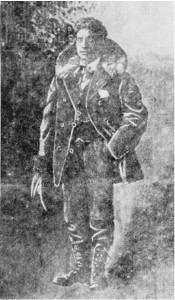One of the small treasures I brought back to New York from Lake Superior is Hannu Leppanen and Daniel Schneider’s 2013 letterpress edition of Tyomies, the Finnish workingman’s newspaper published during the strike of 1913. I’ve mentioned the project here before. Daniel set up his Chandler & Price Pilot Press at the Copper Country Community Arts Center in Hancock and turned out a limited edition broadside with the original Finnish text accompanied by an English translation.
I was lucky enough to cross paths with Daniel briefly at Michigan Tech last Thursday. I gave him copy of 1913 Massacre and he gave me his Tyomies.
No sooner did I open up the package than I came across the following passage:
Apparently, the bars of the city have already embarked to advocate the interests of the mining companies. In Italian and other language bars, it has been explained to the miners that the Finns have gone to work, and in Finnish bars people have been told that the Italians have not begun the strike. However, this is all a devious lie, by which means they try to create despair among the miners, and thus break their strike. Therefore, workers, do not believe what you are told in the bars. If you want to get information about the strike, you will get the right information in the union office.
This confusion of languages and the “despair” it caused helps put Tyomies in context. The union-busting disinformation campaign took advantage of the fact that many of the striking miners in 1913 could not communicate with others outside their own ethnic group. The plan — as someone in the audience at the DeVos Art Museum last Saturday remarked — was to generate and perpetuate distrust among the different ethnic groups: Italians vs. Finns, Croatians vs. Cornish, and so on.
As Arthur Thurner explains in Rebels on the Range, the Western Federation of Miners could not even try to organize the miners of the the Keweenaw until they found a way to counter these tactics. They had met with the same difficulties in a failed bid to organize the iron miners on the Mesabi Range in 1906 and 1907. Vincent St. John, a WFM board member, pointed to the need in 1906 for “competent organizers who speak Finnish, Italian, Austrian, Slovenian and Polish.”
One such organizer among the Italians of the Keweenaw was Teofilo Petriella, a veteran of the Mesabi range strike. In 1907, the Mesaba Ore denounced him as an “alien Dago anarchist.” His biographers in I Figli Della Campagna: Ensayos sobre la emigracion de los campanos en Argentina merely say that he was “stubborn” and that his political ideas often prevented him from getting work. (That echoes Petriella’s own self-description, which is preserved in the 1907 Proceedings of the WFM.)
Petriella and his wife Anita came to the United States in 1900, after he had had been fired for his politics from his job as a schoolteacher in Circello, a village in the Italian Campania, in the province of Benevento. He first got involved with IWW, then, in Minnesota, with the WFM. In 1913, we find him in Calumet, in the pay of the Socialist Party. His was probably a familiar face at the Italian Hall.

